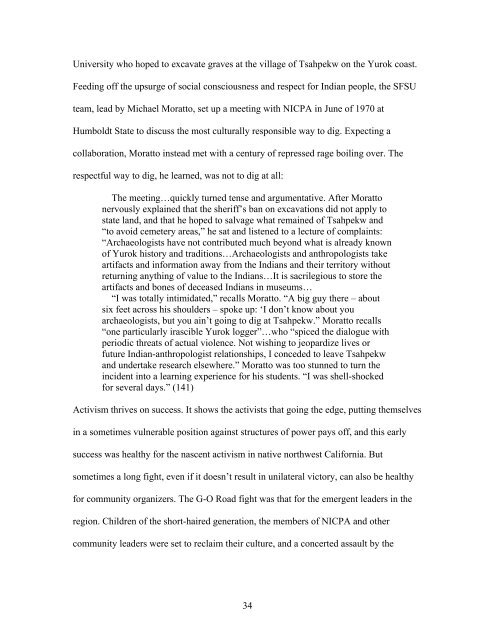The Intersection of Karuk Storytelling and Education
The Intersection of Karuk Storytelling and Education
The Intersection of Karuk Storytelling and Education
You also want an ePaper? Increase the reach of your titles
YUMPU automatically turns print PDFs into web optimized ePapers that Google loves.
University who hoped to excavate graves at the village <strong>of</strong> Tsahpekw on the Yurok coast.<br />
Feeding <strong>of</strong>f the upsurge <strong>of</strong> social consciousness <strong>and</strong> respect for Indian people, the SFSU<br />
team, lead by Michael Moratto, set up a meeting with NICPA in June <strong>of</strong> 1970 at<br />
Humboldt State to discuss the most culturally responsible way to dig. Expecting a<br />
collaboration, Moratto instead met with a century <strong>of</strong> repressed rage boiling over. <strong>The</strong><br />
respectful way to dig, he learned, was not to dig at all:<br />
<strong>The</strong> meeting…quickly turned tense <strong>and</strong> argumentative. After Moratto<br />
nervously explained that the sheriff’s ban on excavations did not apply to<br />
state l<strong>and</strong>, <strong>and</strong> that he hoped to salvage what remained <strong>of</strong> Tsahpekw <strong>and</strong><br />
“to avoid cemetery areas,” he sat <strong>and</strong> listened to a lecture <strong>of</strong> complaints:<br />
“Archaeologists have not contributed much beyond what is already known<br />
<strong>of</strong> Yurok history <strong>and</strong> traditions…Archaeologists <strong>and</strong> anthropologists take<br />
artifacts <strong>and</strong> information away from the Indians <strong>and</strong> their territory without<br />
returning anything <strong>of</strong> value to the Indians…It is sacrilegious to store the<br />
artifacts <strong>and</strong> bones <strong>of</strong> deceased Indians in museums…<br />
“I was totally intimidated,” recalls Moratto. “A big guy there – about<br />
six feet across his shoulders – spoke up: ‘I don’t know about you<br />
archaeologists, but you ain’t going to dig at Tsahpekw.” Moratto recalls<br />
“one particularly irascible Yurok logger”…who “spiced the dialogue with<br />
periodic threats <strong>of</strong> actual violence. Not wishing to jeopardize lives or<br />
future Indian-anthropologist relationships, I conceded to leave Tsahpekw<br />
<strong>and</strong> undertake research elsewhere.” Moratto was too stunned to turn the<br />
incident into a learning experience for his students. “I was shell-shocked<br />
for several days.” (141)<br />
Activism thrives on success. It shows the activists that going the edge, putting themselves<br />
in a sometimes vulnerable position against structures <strong>of</strong> power pays <strong>of</strong>f, <strong>and</strong> this early<br />
success was healthy for the nascent activism in native northwest California. But<br />
sometimes a long fight, even if it doesn’t result in unilateral victory, can also be healthy<br />
for community organizers. <strong>The</strong> G-O Road fight was that for the emergent leaders in the<br />
region. Children <strong>of</strong> the short-haired generation, the members <strong>of</strong> NICPA <strong>and</strong> other<br />
community leaders were set to reclaim their culture, <strong>and</strong> a concerted assault by the<br />
34
















